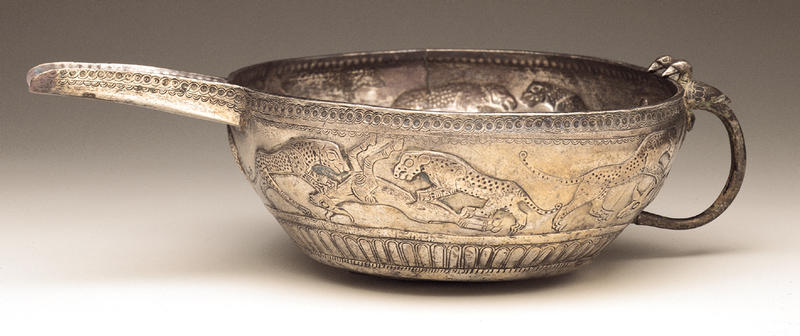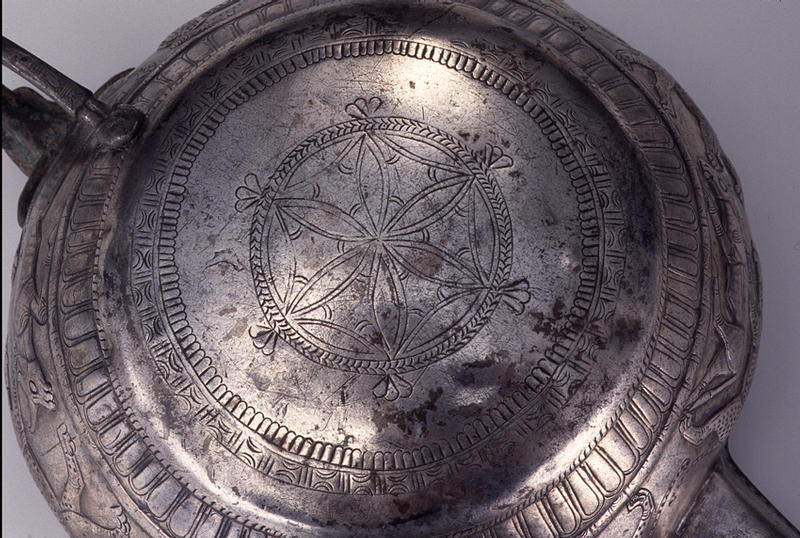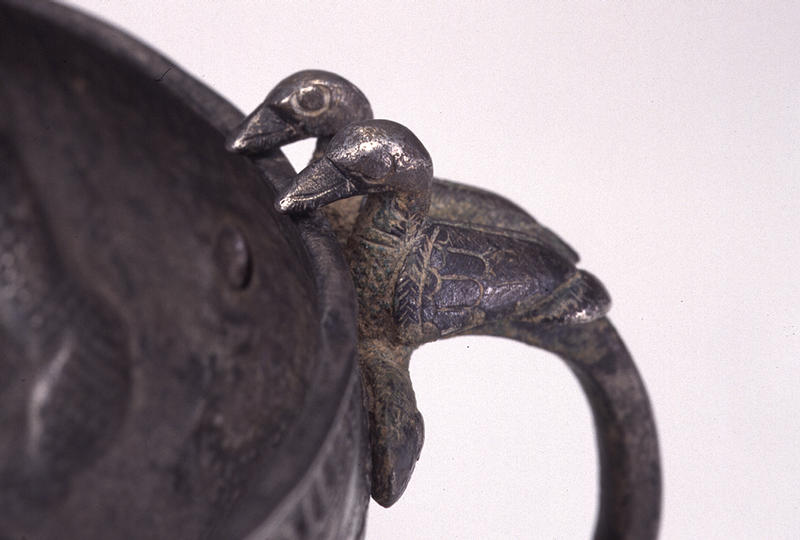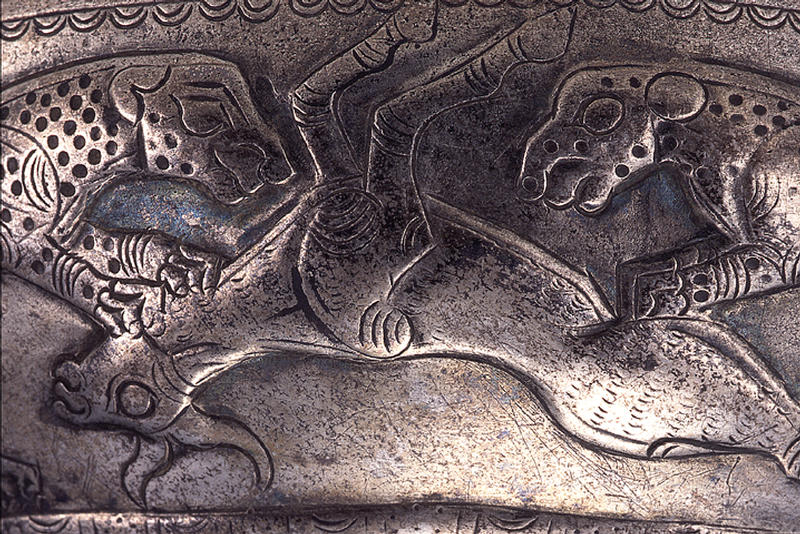注口把手付容器
- イラン北西部
- 紀元前9-紀元前7世紀
- 銀
- H-5.3 D-12 W-20.3
この作品は注口と把手のつけられた銀器であるが、把手を他にすればその形態は西アジアでは長い伝統のあるものである。把手の上の鴨に似た鳥の意匠は前一千年紀エラムの陶器にその類例を求めることができるがその関連性は疑問である。器壁に描き出された豹のような猛獣が牡牛を襲う意匠は他に見られないものである。この組み合わせは古代の星座の組み合わせに相当し新年を象徴する重要なものであったと想像される。この動物闘争意匠は、この伝統的な組み合わせがユーラシアステップ由来の動物闘争意匠に転換されたものであった可能性が考えられる。
Catalogue Entry
This shallow silver bowl has a small beak-spout worked in one piece with the bowl. A separately cast, T-shaped handle is riveted vertically to the opposite side. At the top of the handle sit a pair of duck-like birds whose heads rise above the rim. Around the side of the bowl an animal frieze-showing four bovines, each attacked by a pair of spotted felines-is worked in repouss with chased and incised details. The composition of this frieze begins beneath the spout, where a spotted cat leaps to each side over the body of a bovine. To the viewer's right the bovine arches on its back, forelegs flailing weakly; the second cat claws the vulnerable underside. On the left side the bovine collapses to the ground, one hind leg extended back, while a second spotted cat mauls the head. The remaining space around the sides and back of the bowl is filled with the remaining two bulls and four cats. Although the frieze appears complex in its arrangement, two of the four bulls are the same image and the eight leopards display only minor variations on two basic forms.
On its flat base the bowl bears a concentric arrangement of patterned bands centered around a six-petaled, compass-drawn rosette. Additional bands of ornament including a tongue or petal band extend some distance up the side of the vessel beneath the animal frieze.
Beak-spouted vessels are generally associated with northern and western Iran, where they are known in ceramic.1 The site of Marlik has yielded a number of spouted vessels and fragments of such vessels in both ceramic and metal. The gold and bronze examples are similar to the Shumei bowl in general shape and the decor of the base.2 A cast T-shaped handle identical, except for the birds, to the Shumei handle is riveted to one cup from Marlik; a second handle on another Marlik fragment is similar.3 Fragments of compass-drawn rosettes and tongue or petal bands excavated at Marlik4 provide other parallels. The dates of the Marlik tombs are uncertain,5 nonetheless, a date in the earlier portion of the first millennium B.C. rather than the late second millennium is probable given the shape of this vessel. A place of production in northwestern Iran is likely given the lack of parallels from Sorkh Dum-i Luri and Susa.
The subject of the frieze is the bowl's most unusual chracteristic. Spotted cats are relatively rare in the art of Mesopotamia, where the maned lion has been the more common feline. Iranian examples such as those painted on early ceramics from Tepe Sialk6 and Tepe Hissar7 are more numerous, and related examples are known from the Caucasus.8 Spotted felines occur on only one vessel at Marlik,9 and no scenes combining cats and cattle have been reported. Spotted cats appear on a few unprovenanced examples as well.10
Spotted cats still exist on the Iranian plateau,11 though they are not usually large enough to bring down cattle. It may be, however, that this representation of leopards dominating cattle is symbolic rather than naturalistic.
TSK
1. Kawami 1992, p. 133.
2. Negahban 1983, no. 10, pp. 19-20, no. 57, pp. 52, 82-84, no. 63, p.88.
3. Ibid., nos. 36, 37, pp. 70-71, and Tomb 27, Tomb 44, p. 87, upper right.
4. Ibid., p. 80, nos. 54, 55, pp. 87-88, no. 63.
5. Muscarella 1984, pp. 415-17.
6. Kawami 1992, pp. 44-45; Ghirshman 1938-39, pls. LXXX-LXXXII.
7. Schmidt 1937, p. 49, fig. 38 and 30, p. 110, fig. 65, pls. XIII, XXI, XXXIII.
8. Oganesian 1992, p. ??. [AU: page nos?]
9. Negahban 1983, no. 19, pp. 54-57.
10. Amiet 1976, pl. 95; Louvre AO 25003.
11. Leyhausen 1990, pp. 24-46.



